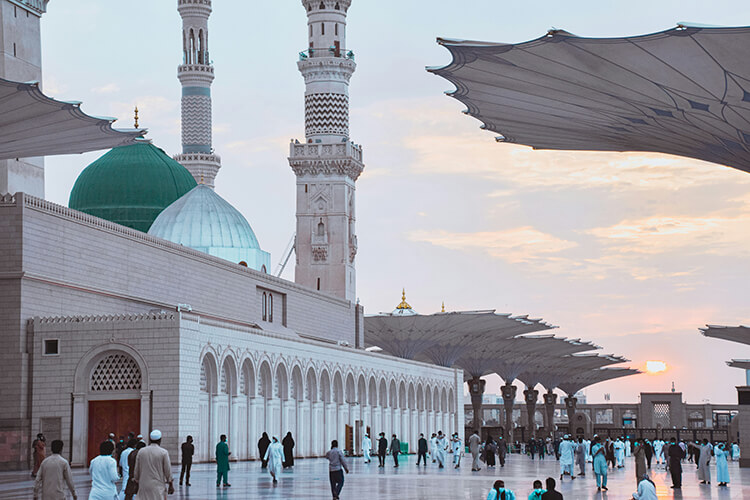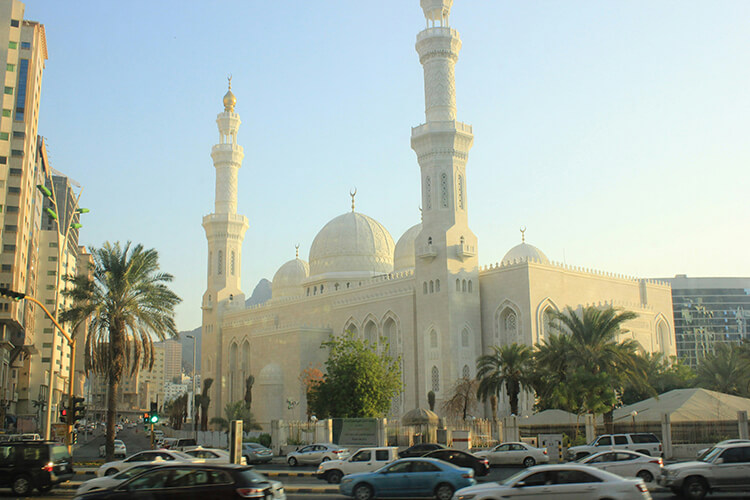There’s a rhythm to western Saudi Arabia that feels both ancient and unexpectedly new. This is a region where time seems layered—where sacred traditions echo through the alleyways of old cities, and sleek, modern transport glides across desert sands. From the spiritual heart of Islam to a coastline blooming with ambition, the Kingdom’s west invites you to trace a journey unlike any other.
Here, pilgrimage and progress aren’t at odds. They move together, side by side, crafting an experience where reverence meets innovation. Whether you’re here to explore faith, heritage, or just the quietly evolving landscapes of a nation redefining itself, the west of Saudi Arabia offers stories waiting to be uncovered.

The Sacred Journey: Medina to Mecca
For centuries, pilgrims have journeyed between Medina and Mecca—cities at the core of Islam’s spiritual history. The journey once took days by camel across vast stretches of desert. Today, it takes just over two hours on the gleaming high-speed train from Medina to Mecca, which is as much a symbol of modernity as it is a thread connecting the past with the present.
Medina, the City of the Prophet, carries a peaceful gravity. Even if you’re not there for religious purposes, the sense of calm that fills its streets is palpable. The Prophet’s Mosque—its minarets rising like candle flames into the sky—is one of the largest in the world, and watching the canopy-like umbrellas open across its courtyard at sunrise is a quiet marvel.
In Mecca, the sacred energy intensifies. Though non-Muslims are restricted from entering the Holy City, the infrastructure surrounding it—hotels, stations, cultural centers—speaks to the deep respect with which the city is held. For Muslims making their way here, the moment of arrival is powerful beyond words. For those outside the faith, the journey still tells a story of devotion, unity, and timeless tradition.

Jeddah: Gateway to the Red Sea and Beyond
To the west lies Jeddah, a city defined by contrasts. It’s the commercial heart of the region and the cultural soul of Saudi Arabia’s coastline. Here, historical architecture rubs shoulders with glass towers, and the scent of frankincense lingers just a few streets away from polished waterfront cafés.
Arriving via the train Jeddah to Madinah, you transition from the Red Sea’s edge to the sandstone tones of the Hejaz interior, all within a journey as smooth as the sand dunes that roll beyond the city limits. The station itself is a showpiece of modern design—sleek, cool, and surprisingly serene.
Jeddah’s Al-Balad district, a UNESCO World Heritage Site, invites slow wandering. Wooden lattice balconies lean toward each other overhead like old friends. The coral-stone buildings here have weathered centuries, and they wear their age proudly. At night, the city’s Corniche comes alive—families stroll beside the waves, food trucks serve everything from falafel to fresh shrimp, and the King Fahd Fountain casts misty rainbows over the sea.
Discovering AlUla: A Landscape Written in Stone
If Mecca and Medina are the spiritual heart of the west, AlUla is its poetic soul. Tucked deep into the desert, AlUla’s otherworldly rock formations and Nabataean tombs feel like something conjured from legend. In recent years, it’s emerged as a cultural hub—blending history, art, and high-end experiences with remarkable sensitivity.
Hegra, often described as Saudi Arabia’s Petra, is the country’s first UNESCO site. Carved into rose-coloured cliffs, the tombs of this ancient trading civilisation are astonishing in their scale and preservation. But there’s more here than ruins. Contemporary art installations appear among the stones, and music festivals echo through desert canyons during winter months.
Luxury accommodation blends seamlessly into the setting—think tented suites with glass walls that frame the stars, or eco-lodges carved into rock. AlUla isn’t just about what you see. It’s about what you feel—that rare hush where the landscape speaks louder than any guidebook.
Tradition Reimagined
One of the most compelling aspects of traveling through Saudi Arabia’s western region is how the old ways aren’t being replaced—they’re being re-framed. You’ll find artisan markets that still sell handwoven baskets and intricate calligraphy, but now they sit beside boutique concept stores showcasing local fashion and perfume brands with global appeal.
Cuisine, too, bridges the past and present. In Madinah, you might share a dish of kabsa (spiced rice with meat) on a woven mat, while in Jeddah, you can book a table at a rooftop restaurant serving sea bass with saffron foam and pomegranate reduction. Hospitality here is never just transactional—it’s layered with culture, pride, and generosity.
Sustainability and the Spirit of Place
The Kingdom’s Vision 2030 initiative has spurred dramatic developments—but there’s a conscious effort in the west to tread lightly. New resorts near the Red Sea are being designed with coral preservation in mind, while in the deserts around AlUla, local communities are being included in decisions about land use, conservation, and tourism.
Travelers now have the chance to engage with the region in more meaningful ways—joining heritage walks led by local guides, learning the stories of ancient trade routes, or even taking part in pottery or Arabic coffee workshops that connect you to centuries of tradition.
A Journey That Grows With You
Western Saudi Arabia is still something of a mystery to most of the world, but perhaps that’s what makes it so captivating. It’s not polished to perfection. It doesn’t cater to every whim. But it offers something better—authenticity, warmth, and a chance to walk paths that hold meaning beyond just miles.
Whether you’re marveling at the scale of a mosque, sipping strong qahwa beneath palm trees, or standing alone in a sun-drenched canyon with nothing but wind for company, the west of the Kingdom invites you not just to explore, but to reflect.
Traveling across Saudi Arabia’s western corridor is like reading a story written in stone, stitched with prayer, and illuminated by the sun. The blend of sacred sites, striking architecture, and natural beauty creates an experience that is both grounding and uplifting.
From the high-speed train, gliding through holy lands, to the cosmopolitan energy of Jeddah’s corniche and the haunting silence of AlUla’s tombs, every stop is a page in a journey rich with meaning.
This isn’t just a destination. It’s a conversation between the past and the future—and one that welcomes you, gently but unmistakably, to listen.